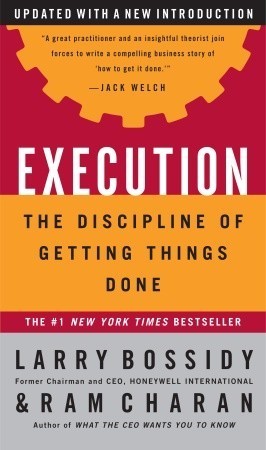More on this book
Community
Kindle Notes & Highlights
Follow-through is the cornerstone of execution, and every leader who’s good at executing follows through religiously. Following through ensures that people are doing the things they committed to do, according to the agreed timetable. It exposes any lack of discipline and connection between ideas and actions, and forces the specificity that is essential to synchronize the moving parts of an organization. If people can’t execute the plan because of changed circumstances, follow-through ensures they deal swiftly and creatively with the new conditions.
Never finish a meeting without clarifying what the follow-through will be, who will do it, when and how they will do it, what resources they will use, and how and when the next review will take place and with whom. And never launch an initiative unless you’re personally committed to it and prepared to see it through until it’s embedded in the DNA of an organization.
Once I embrace an initiative, I make sure it’s put into effect. If I let it wane after six months, wasting money and people’s time, that’s going to reduce my effectiveness in making future initiatives. People will think, “We’ll give this three months, and ol’ Larry will be off on something else,” and their body language will show that they’re skeptical. So I make a point of emphasizing that I’m committed and that we’re going to do this. We may do it with or without everybody’s support, but we’re going to do it. Then people get the message quickly that this is not an experiment.
When you interview, you have to create a full picture of the person in your mind based on things you can learn by probing them. Then you need to find out about their past and present accomplishments, how they think, and what drives their ambitions.
The first things I look for are energy and enthusiasm for execution. Does the candidate get excited by doing things, as opposed to talking about them? Has she brought that energy to everything she’s done, starting with school? I don’t care if she went to Princeton or to Podunk State; how well did she do there? Is her life full of achievement and accomplishment?
What does this person want to talk about? Does she talk about the thrill of getting things done, or does she keep wandering back to strategy or philosophy? Does she detail the obstacles that she had to overcome? Does she explain the roles played by the people assigned to her? Does she seem to have the ability to persuade and enlist others in a mission?
When I’m assessing an outside candidate, I want to verify his past. It’s essential to talk directly to his references. When I arrived at AlliedSignal, I personally checked references for dozens of candidates. I remember fellow CEOs asking, “Why are you calling?” I’d answer that it was a personal concern of mine. If I’m going to hire someone, I don’t want only human resources people checking him out; I want to check him out myself. And I don’t talk to just one reference and leave the rest to HR; I try to...
This highlight has been truncated due to consecutive passage length restrictions.
Many CEOs have told me that my reference calls were different from most because I focused so much on the candidate’s energy, implementation, and accomplishments. I ask, “How does he set priorities? What qualities is he known for? Does he include people in decision making? What is his work ethic and his energy level?” Those types of questions get at the person’s real potential. When I make a call personally, I know I’m more likely to get a candid response. If I know the reference, I’ll feel confident that I’m not getting any filtering. If I can’t readily get a reference from a person I know,
...more
This highlight has been truncated due to consecutive passage length restrictions.
One of the many things mechanical evaluations miss is how candidates performed in meeting their commitments—whether they did so in ways that strengthened their organizational and people capability as a whole or weakened it. How leaders meet their commitments is at least as important as whether they meet them and is often
more important. Meeting them the wrong way can do enormous damage to an organization.


